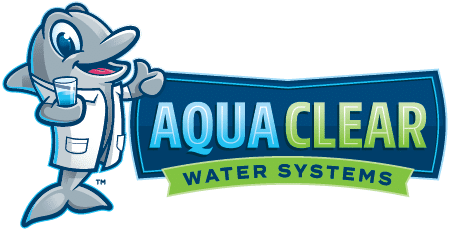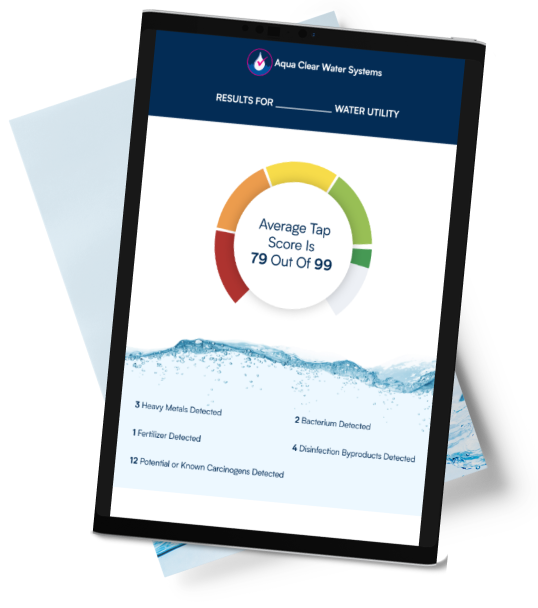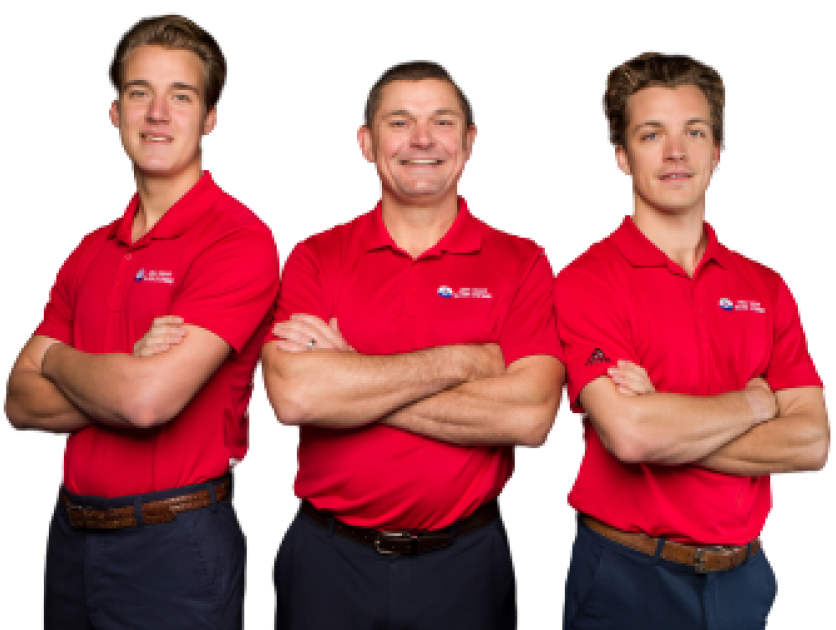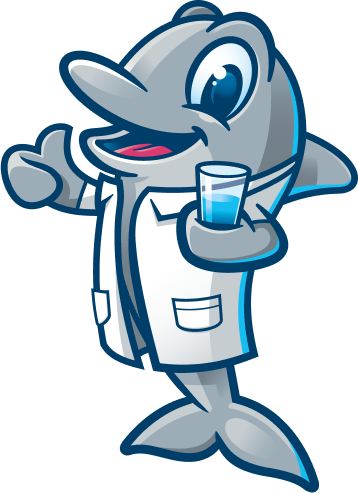Municipal water systems disinfect tap water to stop water-borne disease. The most common disinfectants are chlorine and chloramine. Disinfection has saved countless lives, yet many households still want to reduce disinfectant taste and odor, protect fixtures, and minimize exposure to disinfection by-products at the point of use. This guide explains what these chemicals do, why utilities use them, the side effects people notice at home, and how to treat them effectively.
Quick facts
- Utilities add low levels of chlorine or chloramine to kill germs as water travels through miles of pipe to your home.
- The “free chlorine” residual and the “monochloramine” residual do not behave the same in plumbing or filtration.
- Disinfectants can react with natural organic matter to create disinfection by-products (DBPs) such as TTHMs and HAA5, which are regulated at very low levels.
- Home treatment can reduce chlorine, chloramine, and many DBPs before water reaches your taps and showers.
Where our local water comes from
Across East Tennessee, most residents receive water sourced from rivers, lakes, and streams, especially the Tennessee River. Surface water typically needs a persistent disinfectant residual, so utilities maintain measured levels of chlorine or chloramine through the distribution system.
Chlorine and chloramine 101
|
Topic |
Chlorine |
Chloramine |
|
What it is |
Free chlorine residual (Cl₂ hypochlorous forms) |
Typically monochloramine formed by combining chlorine and ammonia |
|
Why utilities use it |
Strong, fast germ kill at the plant, good for periodic “burns” of biofilms |
More stable in long pipe networks, forms fewer DBPs than free chlorine in many systems |
|
What people notice |
Pool-like taste and odor, can dry skin and hair |
Milder smell, but can still irritate sensitive users, may be tougher to remove |
|
By-products |
Can form TTHMs and HAA5 when reacting with natural organics |
Usually fewer TTHMs than chlorine, but still forms DBPs, different chemistry |
|
At the tap |
Can dissipate if left standing in open air |
Does not dissipate by standing, requires catalytic media to treat |
|
Special cautions |
Sensitive fish and dialysis water must be dechlorinated |
Same cautions, and chloramine requires different removal methods |
Side effects households often report
- Taste and odor at sinks and showers
- Dry skin and hair, fading of hair color with long hot showers
- Rubber and elastomer wear in toilet flappers and faucet seals over time
- Fixture staining or scale when disinfectant chemistry interacts with minerals
- Formation of DBPs such as trihalomethanes when disinfectant meets natural organics
Chlorine levels in distribution may vary during the year. Customers may notice stronger taste during seasonal maintenance or when a utility temporarily switches from chloramine back to free chlorine to clean mains.
About disinfection by-products (DBPs)
When disinfectants contact natural organic matter, regulated DBPs can form. Two major families are:
- TTHMs: chloroform, bromodichloromethane, dibromochloromethane, bromoform
- HAA5: five haloacetic acids measured together
Utilities must keep system-wide averages under strict limits, yet homeowners who are sensitive to taste or who want additional reduction can use point-of-entry and point-of-use filtration to lower what reaches the tap.
Practical treatment that works at home
Goal: remove disinfectant taste and odor, reduce many DBPs, and protect plumbing without harming flow.
Most effective media for the job
- Granular Activated Carbon (GAC), excellent for free chlorine and many DBPs
- Catalytic GAC (cGAC), modified carbon that is far better for chloramine and chloramine-related by-products
- Carbon block cartridges, high contact time at the sink for drinking and cooking
- KDF media can assist with free chlorine in mixed beds, not a primary chloramine solution
Whole-home options
- Backwashing GAC or catalytic GAC tank
- Treats chlorine or chloramine at the point of entry
- Restores flow with automated backwash cycles
- Sized for your peak household demand and required empty-bed contact time
- Static media tank with prefiltration
- Lower maintenance in low-sediment homes
- Requires careful sizing for chloramine to ensure adequate contact time
Point-of-use options
- Under-sink carbon block for cooking and drinking
- Refrigerator or pitcher filters for flavor improvement, confirm ratings
- Shower filters with catalytic carbon when chloramine is present
Important sizing notes
- Chloramine needs more contact time than chlorine. Undersized filters will not fully reduce chloramine.
- Use a 5-micron sediment prefilter to protect carbon beds and valves.
- Match the backwash flow to your plumbing so the media bed lifts and cleans correctly.
What you can do today
- Read your Consumer Confidence Report (CCR): see which disinfectant your utility uses and the system’s DBP results.
- Check residuals: a simple pool test can show free chlorine or total chlorine at the tap, which hints at chloramine if free is low and total is higher.
- Target the right filter: GAC for free chlorine, catalytic GAC for chloramine.
- Protect sensitive uses: dechlorinate water for aquariums and ensure dialysis water is treated per medical specifications.
Our approach in Tennessee
At Aqua Clear Water Systems, we design backwashing and static carbon systems for both chlorine and chloramine, using certified media and valves sized to your plumbing, peak flow, and water chemistry. We also pair whole-home solutions with under-sink drinking systems when families want extra polishing for taste.
We handle:
- Site evaluation and flow calculation
- Media selection, tank sizing, and backwash configuration
- Maintenance plans, including prefilter changes and media life tracking
Want a precise recommendation for your home? Send us your address and a recent water report, or we can test on site and size a system that meets your goals.
FAQs
Why are chlorine and chloramines used in the municipal water system?
They keep water microbiologically safe as it travels through the distribution system. A small residual continues to kill germs between the plant and your tap.
What are the side effects of chloramine in drinking water?
Most people notice taste and mild odor. Some report dry skin or hair. Chloramine does not dissipate by standing, so sensitive users often prefer catalytic carbon at the point of entry or point of use.
What are the consequences for not properly monitoring chlorine or chloramine levels in water?
If residuals are too low, germs can regrow in pipes. If too high, customers notice stronger taste and odor and utilities may see elevated DBP formation when disinfectant reacts with organics. Utilities continuously monitor to stay within strict standards.
Is municipal water treated with chlorine?
Many systems use free chlorine all or part of the year. Others use chloramine as the primary residual because it persists longer in large pipe networks and can form fewer regulated DBPs. Some systems switch seasonally.
Will a whole-house filter remove chlorine and chloramine?
Yes, when it uses the right carbon media and is sized for contact time and peak flow. Standard GAC handles free chlorine well. Catalytic GAC is preferred for chloramine.
Does letting water sit out remove disinfectants?
Free chlorine can dissipate in open air. Chloramine will not, it requires catalytic media or chemical neutralization.
Do shower filters work on chloramine?
Some do, but they need catalytic carbon and adequate contact time. Many small shower filters focus on free chlorine and are less effective on chloramine. Whole-home treatment provides the most consistent result.
Are DBPs removed by home filtration?
Many DBPs are reduced by high-quality activated carbon. Results improve with proper sizing, fresh media, and adequate contact time.
Is water safe for pets?
Dogs, cats, and birds tolerate the low levels used in drinking water. Fish, amphibians, and reptiles absorb water directly and require dechlorinated, dechloraminated water.
Will carbon filtration affect water pressure?
A correctly sized whole-home system maintains household pressure. Undersized cartridges or clogged prefilters are common causes of pressure drop.







